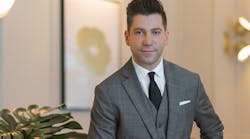Emerging Designer Arthur Garcia-Clemente Strives to Serve Others Through Design
To gauge the fate of the field, interiors+sources recently spoke with five young interior designers known to question the status quo.
These five individuals, featured on the cover of our August issue, are still in the early stages of their design journeys, but have already learned a lot along the way.
Arthur Garcia-Clemente is one of these emerging designers who is ready to share his tips and advice for those looking to enter the trade. Learn from him through his story below.
ShopRunner is a tech startup that works closely with retails brands and consumers, particularly high-end retailers.
“The office wanted partnerships with these high-end clients, while proving to its investors its capacity for running a financially-prudent business,” explains Garcia-Clemente. “The office is to be one of the most inclusive and best places to work in the Chicago-land area, but also to serve as an example of a successful tech company that moved to Chicago from the West Coast.”
High Expectations Affect Young Designers
Arthur Garcia-Clemente was drawn to interior design for several reasons: “I could utilize my past economics education and experience working with business owners,” he says. “I could participate in the creative process on a regular basis, and it was a means by which I could drastically improve the lives of so many people, particularly through workplace design.”
Rio Tinto is one of the world’s largest metal and mining companies. For its new North American headquarters, the company wanted a professional office for people on the move, including those who travel often or routinely host clients. The new design now tells the history of Rio Tinto, while serving as a refuge for its North America workforce.
Now an interior designer for Partners by Design, Garcia-Clemente works almost exclusively in corporate headquarters design in the downtown Chicago area. He says he enjoys being a part of projects where he has the opportunity to modernize a company’s approach to its workplace.
“The work world in general has become much more entrepreneurial, even for the typical employee,” says Garcia-Clemente. “The rewards of great performance have increased tremendously, but the expectation that the employee self-direct their own growth and development have also increased.”
“These are all rewards that top-performing individuals can obtain,” explains Garcia-Clemente.
“But on the flip side, it is often expected that employees arrive fully-informed; that they have already invested the necessary time and energy in themselves to reach this deserving stage. And once at the firm, companies are expecting their top talent to self-motivate and be self-directed,” he continues.
Focusing on Service-Centered Design
He notes this can pose a challenge to young designers when deciding which direction to take their career.
When he completed the final leg of his initial three-part plan to enter the interior design world (education, experience, licensing) Garcia-Clemente found himself asking: Which skills and talents are most critical to develop now? A year from now? Five years from now?
“At the end of the day, I’ve come to see that you need to develop both your strengths and weaknesses, but not in equal measure,” he says. “Instead of focusing on my weaknesses, I’ve found that it pays much greater dividends to focus intensely on the things you are doing very well, and then become the absolute best at them. For me, my strength lies in working closely with my clients—becoming a trusted advisor that makes their design process fun, exciting and without worries.”
Garcia-Clemente adds that service to others should be designers’ driving focus.
This Month’s Profiles:
► Arthur Garcia-Clemente at Partners by Design
Jacquelyn Hunter of Corgan
Kyle Berry of AECOM
Tyson Baker of PGAV Destinations
Austin Crowley from Michael Graves Architecture & Design
Never miss the latest developments. Subscribe to our newsletters

